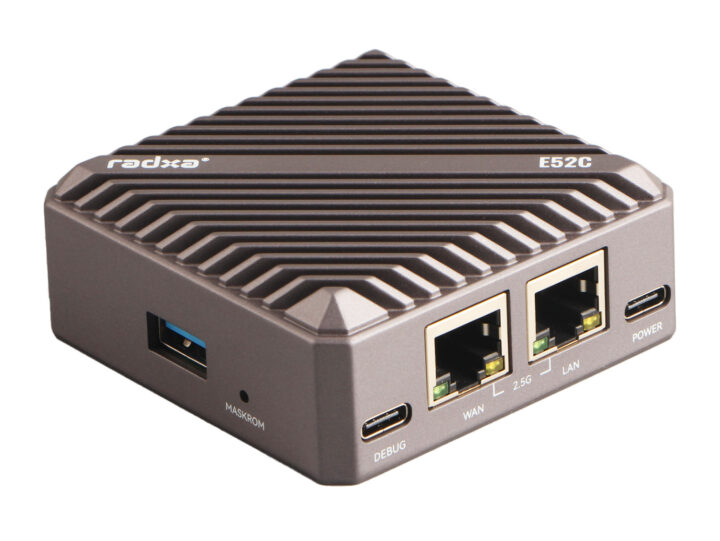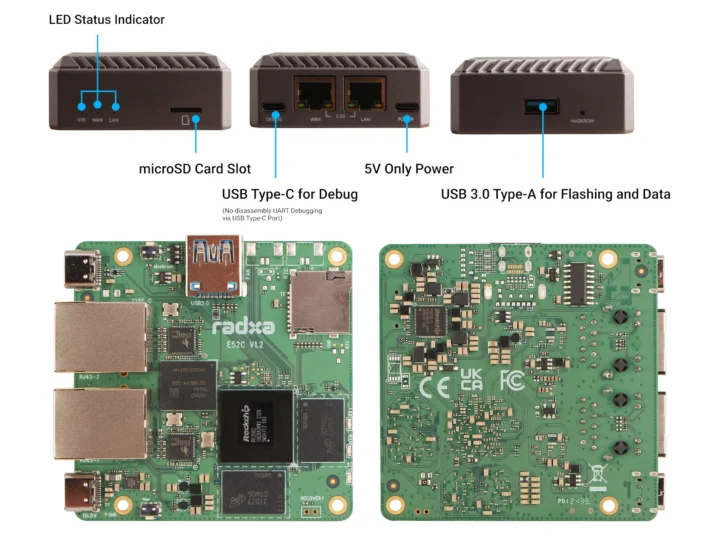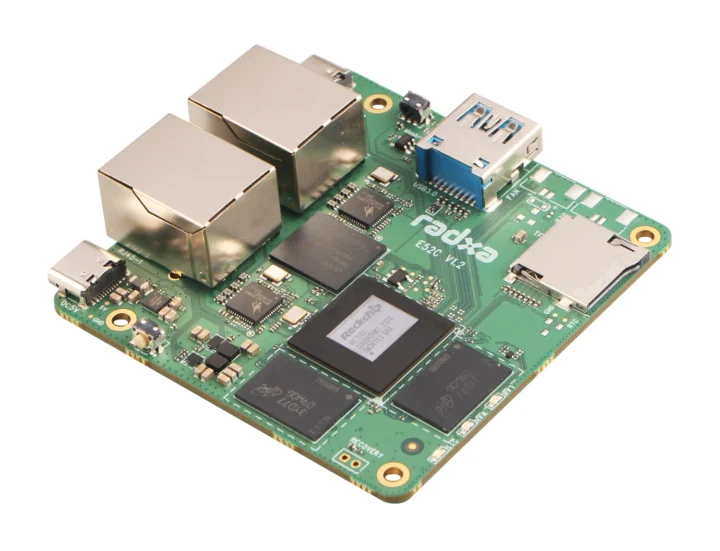Radxa E52C is a compact router based on Rockchip RK3582 hexa-core Cortex-A76/A55 SoC and featuring two 2.5GbE ports, a USB 3.0 port, and a USB-C port for serial console access which will make some readers happy…
It’s an update to the earlier Radxa E20C “Mini Network Titan” router, which was limited to two Gigabit Ethernet ports and a USB 2.0 port, and powered by an entry-level Rockchip RK3528A quad-core Cortex-A53 SoC. The Radxa E52C is better in every way with a much faster CPU, higher maximum memory and flash storage capacities, faster networking, and support for USB 3.0 storage or wireless dongles leading the company to call it an “Enhanced Mini Network Titan”.
Radxa E52C specifications:
- SoC – Rockchip RK3582
- CPU
- Dual-core Cortex-A76 with up to 2.4 GHz
- Quad-core Cortex-A55 at up to 1.8GHz
- GPU – None (all good since we are talking about a router here…)
- AI accelerator – 5 TOPS NPU
- CPU
- Memory – 2GB, 4GB, or 8GB LPDDR4
- Storage
- 16GB, 32GB, or 64GB eMMC flash
- MicroSD card slot
- Networking – 2x 2.5GbE RJ45 ports via Realtek RTL8125BG controllers
- USB – 1x USB 3.0 Type-A port for data and flashing firmware
- Debugging – USB-C port for serial console access
- Misc
- User button
- Maskrom pinhole
- WAN, LAN, and System LEDs
- Power Supply – 5V DC via USB Type-C port; 3A recommended when connecting peripherals to the USB 3.0 port
- Dimensions – 72 x 72 x 28.7 mm (Aluminum alloy enclosure)
On the software side, it’s pretty much the same as for the E20C router with the E52C board running Debian Linux, FLippy OpenWrt, or iStore OS, another fork of OpenWrt with a user interface that aims to simplify the configuration process and also allows the user to easily configure the system as a simple USB NAS. Radxa also provides a hardware access/control library for Linux. But none of that appears to be available right now as the Download section on the product page only contains links to a product brief, schematics (PDF), a components placement map, and 2D drawings at this time.
You can already order the Radxa E52C with 2GB RAM and 16GB flash only on Arace Tech or AliExpress for about $55-$56. Other models are out of stock, but the 4GB/32GB version will go for $65, and the 8GB/64GB variant for $85. Radxa guarantees supplies for the Radxa E52C until at least September 2034. Note that’s the second Rockchip RK3582-based product from the company, as the Radxa ROCK 5C (Lite) was launched a few months ago as a GPU-less Raspberry Pi 4/5 alternative.

Jean-Luc started CNX Software in 2010 as a part-time endeavor, before quitting his job as a software engineering manager, and starting to write daily news, and reviews full time later in 2011.
Support CNX Software! Donate via cryptocurrencies, become a Patron on Patreon, or purchase goods on Amazon or Aliexpress







